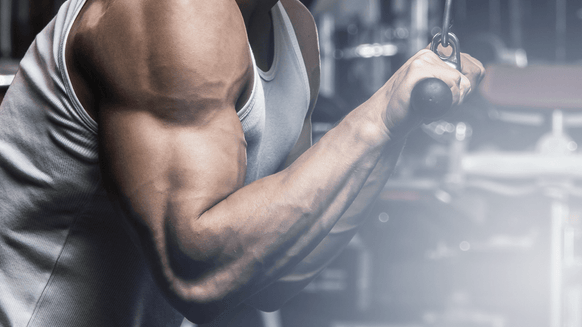Can You Still Build Muscle With Just Bodyweight Training?

One of the great misconceptions of not having access to gym equipment is that you will not be able to build muscle. This is absolutely not the case! You only have to look as far as the popular callisthenics movement or gymnastics to see some truly impressive physiques.
However, the approach you take will differ as the methods you use to drive muscle growth may not be as straightforward as increasing weight on the bar or changing the resistance on the machine.
Understanding the nature of how we develop muscle comes first. If we know how to build it, then we know what aspects of our program we can adapt, change or even look for new elements to introduce to continue to build that hard-earned muscle.

What causes muscle growth?
Muscle growth or “muscle hypertrophy” has been proposed to occur due to three main contributing mechanisms. The first is mechanical tension which is the resistance applied to the muscle.
The second is metabolic stress which refers to the accumulation of metabolites, produced by metabolic processes associated with exercise, that give you that “burning” feeling.
The final mechanism is muscle damage which is the pain and or swelling associated with exercise induced muscle damage.1
When designing a program with the primary goal focused around muscular hypertrophy, basing it on movements, rep and set schemes, time under tension and other approaches that take into consideration these three primary contributors to muscle growth will provide the best results.
Of course, it isn’t just what we do during our programmed exercise that will impact muscle growth. Adequate nutrition, sleep and stress management will all impact how successful a hypertrophy program is.
How to implement these concepts into home workouts?
Firstly, we have to consider what is available to us and which of the three contributors to muscle hypertrophy we should focus on based on equipment availability.
Mechanical tension
The obvious limitation is going to be how much we can progress within mechanical tension. With limited gym equipment and the focus of our training program being predominantly bodyweight exercises, there’s only so much you can do which is focused around increasing load on the muscle.
Adding in resistance bands can help increase tension or load as can altering movement patterns or increasing the difficulty of exercises you do.
An example of this would be progressing from doing a push up with your knees on the ground to a traditional push up where the feet and hands are the only points of contact with the ground.
Another example would be doing triceps dips on a chair and eventually progressing into dips where you are supporting your entire bodyweight.
You could also look to incorporate new movement patterns, such as handstand push-ups and split squats from a chair or elevated surface.
Safety is paramount here and so be mindful to have someone there to support you if you are doing more challenging movements, especially those like the handstand push-ups where your neck could be at risk.
Metabolic stress
So, there are two real ways you’re going to be able to increase metabolic stress at home:
1. Upping the reps, “supersets / giant sets”
2. Reducing rest times or restricting blood flow to the focused muscle group
Why does time between reps matter?
With muscles continually contracting and relaxing a blood pooling effect is created within the muscle. This causes the cells to swell which we may know as the “pump”.
This, in turn, results in restricted blood flow to the muscle (which may be referred to as occlusion) which means there is a lack of oxygenated blood being able to fuel the muscle during the continual contractions.
This leads to a large build-up of metabolites within the muscle. The resulting metabolic stress placed on the muscles has an anabolic (muscle building) effect leading to molecular signalling and an increased hormonal response by the body driving hypertrophy.
Occlusion training (where you restrict blood flow to the muscle you’re training) just on its own can be used to induce hypertrophy and sustain muscle mass using much lighter loads and increasing the number of reps performed.2
Applying some kind of restriction (like a tourniquet or tightly wrapped material) to the blood flow to the muscle you’re focusing on and using a lightweight (even something as simple as a kilo bag of sugar) for many reps can help you achieve a similar effect.
Muscle damage
We’ve all experienced the dreaded DOMS (delayed onset muscle soreness) a day or two after a training session. The result of micro-tears in the muscle following exercise, it’s a common sensation that many experience during the recovery and adaptation phase following exercise.
While not everyone who achieves hypertrophy and strength increase will experience DOMS, it’s a noted indicator that hypertrophy is being achieved.
For home workouts, focusing on slowing down the “stretch phase” of the movement will help achieve even more hypertrophy. Try incorporating counts into the stretch phase — counting down from five or ten for example.
It would also be worth separating movements focused on muscle damage and increasing metabolic stress — melding the two may lead to compromises in technique and increased risk of injury.
Conclusion
Building muscle at home with just bodyweight workouts is totally achievable, it just requires a bit of adaptation to your training program.
Knowing what drives muscle hypertrophy will help us focus on the adaptations that will give us the most “bang for our muscle building buck”.
READ THIS NEXT:

14 Chest Exercises For Your Home Workout
If you thought you needed the gym to pump up your pecs, think again.

1. Schoenfeld, B. J. (2010). The mechanisms of muscle hypertrophy and their application to resistance training. The Journal of Strength & Conditioning Research, 24(10), 2857-2872.
2. Loenneke, J. P., & Pujol, T. J. (2009). The use of occlusion training to produce muscle hypertrophy. Strength & Conditioning Journal, 31(3), 77-84.







